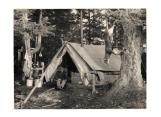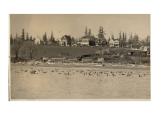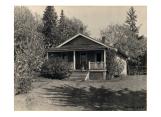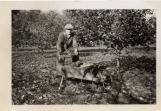2
The land itself stretches back from the shores of the Comox Bay along Brooklyn Creek. Laing was first directed to this location by Ronald Stewart, a fellow ornithologist.3
''The Taverner Party'' of the 1922 ornithological field season.31 May 1922
Vaseux Lake, British Columbia

4
Laing began by preferring the camera to the gun in his study of birds and animals. Some have suggested that Laing's first meetings with fellow ornithologist Allan Brooks may have inspired (or at least solidified) this shift.5
Laing's first dwelling on his new Comox property along Brooklyn Creek.1922
Comox, British Columbia, Canada

6
Stewart recommended the area as a campsite for Laing and the rest of his National Museum party for the last half of the 1922 field season. Laing's impression of the place was so favourable that by October of that year he had bought five acres of land along the creek with plans of making it his home.7
Photo of Comox Bay and main street in 1939, taken by Mack Laing.1939
Comox, British Columbia, Canada

8
Comox was, of course, a much smaller place at that time than it is now. Laing's photo of the main street and waterfront of Comox, taken in 1939, gives some measure of the sort of growth the town has experienced. Laing eventually bought two adjacent lots of second-growth forest, which stretched down to the bay, paying $150 per acre.10
In 1928 Laing married Ethel Hart, his fiancee of several years.11
This is a photo taken by Laing of his first Comox house, ''Baybrook''.1938
Comox, British Columbia, Canada

12
The couple lived on their Comox property, christened "Baybrook" by Ethel, in a pre-built, mail-order Aladdin Readicut house which Laing had assembled in 1923. During the rest of the 1920's, Mack Laing spent a large portion of each year away on collecting expeditions for various museums. During the depressed 1930's, however, the couple began to use their land for nut-farming.13
Laing with a bowlful of filberts from his ''Baybrook'' nut farm.1947
Comox, British Columbia, Canada


